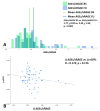AGEs and sRAGE Variations at Different Timepoints in Patients with Chronic Kidney Disease
- PMID: 34943097
- PMCID: PMC8698924
- DOI: 10.3390/antiox10121994
AGEs and sRAGE Variations at Different Timepoints in Patients with Chronic Kidney Disease
Abstract
Patients with chronic kidney disease (CKD) are affected by enhanced oxidative stress and chronic inflammation, and these factors may contribute to increase advanced glycation end-products (AGEs). In this study we quantified AGEs and soluble receptors for AGE (sRAGE) isoforms and evaluated the association between their variations and eGFR at baseline and after 12 months. We evaluated 64 patients. AGEs were quantified by fluorescence intensity using a fluorescence spectrophotometer, and sRAGE by ELISA. Median age was 81 years, male patients accounted for 70%, 63% were diabetic, and eGFR was 27 ± 10 mL/min/1.73 m2. At follow up, sRAGE isoforms underwent a significant decrement (1679 [1393;2038] vs. 1442 [1117;2102], p < 0.0001), while AGEs/sRAGE ratios were increased (1.77 ± 0.92 vs. 2.24 ± 1.34, p = 0.004). Although AGEs and AGEs/sRAGE ratios were inversely related with eGFR, their basal values as well their variations did not show a significant association with eGFR changes. In a cohort of patients with a stable clinical condition at 1 year follow-up, AGEs/sRAGE was associated with renal function. The lack of association with eGFR suggests that other factors can influence its increase. In conclusion, AGEs/sRAGE can be an additional risk factor for CKD progression over a longer time, but its role as a prognostic tool needs further investigation.
Keywords: advanced glycation end-products (AGE); chronic kidney disease (CKD); cleaved RAGE (cRAGE); endogenous secretory RAGE (esRAGE); soluble receptor for AGE (sRAGE).
Conflict of interest statement
The authors declare no conflict of interest.
Figures




References
LinkOut - more resources
Full Text Sources
Research Materials
Miscellaneous

